 |
||||||||||
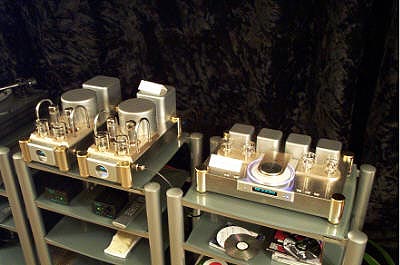 |
Shanling introduced the 50-watt 2 x EL34-based SP-80 monoblocks ($2,495/pr) with 6N8/6N9 drivers, passive attenuator and a clever sync-link that straps both amps together so that the remote volume control adjusts them in tandem if used source-direct. The SCD-T200 ($2,695) is the matching SACD 2-channel machine with Burr Brown 1738 PCM DACs and a Sony KHM transport, mated to the firm's tubed output stage for both analog and headphone outputs. Visually nearly identical to the T-100 tubed CD player, the T-200's chassis is merely taller. Chris Johnson of the PartConnexion and Walter Liederman of The Graham Company are already at work on a mod that they predict will take the stock performance to yet another level. Working in conjunction with Shanling importer "hairy Scot" Roy Hall of MusicHall, these modifications do not void the factory warranty but are exclusively available through Liederman's outfit. |
|||||||||
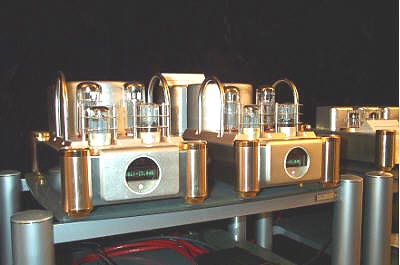 |
||||||||||
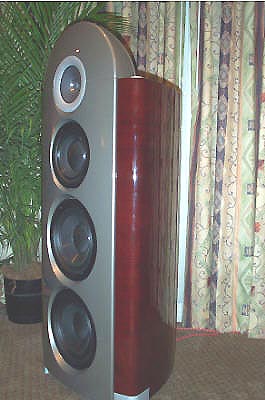 |
||||||||||
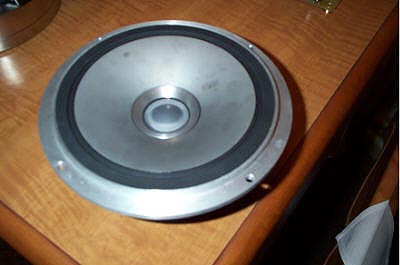 |
||||||||||
 |
||||||||||
TAD Technical Audio Devices is a 28-year old division of Pioneer with a sterling reputation for fabricating the most expensive raw drivers in the world. Building on the legacy of Altec-Lansing and JBL Pro, TAD has over the years securely established itself as the provider of professional loudspeaker solutions for SOTA mastering faciliites, recording studios and commercial movie houses. TAD's specialty are compression-loaded drivers with elaborate wooden horns and vapor-deposited Beryllium HF and midband drivers, the latter a fully developed exclusive technology far ahead of JMlab's recent introduction of spun Beryllium devices. With the vented 4-way Model-1 ($40,000), TAD -- pun intended -- pioneers its new home audio division. A novel CST Coherent Source Transducer (technospeak for a coaxial tweeter/mid unit) is mated to a 200mm tri-laminated woven Aramid fiber/foamed Acrylic composite mid-bass driver and two equivalent 250mm woofers. In similar fashion to Vandersteen's Model 5 head and Gershman Acoustics' egg-shaped Opera Sauvage, the cabinet of the Model-1 is a laminate structure comprised of more than 50 individually machined layers of high-quality birch [left] that allow integrated internal ports (the circular cross-section in the frontal corners) as well as complex alternating cross-braces that don't suffer glue joints but are integral to the "sliced" composite architecture. The midrange enclosure is fashioned from cast aluminum. With a claimed response of 25Hz to 100kHz, crossover points are 100/350/2,200Hz, sensitivity is 90dB, nominal/minimum impedance 8/3.2 ohms, maximum SPLs 115dB and weight an absolutley ungodly 285 lbs each. Dimensions? 54.4" x 22.8' x 22.4" HxWxD. |
||||||||||
 |
||||||||||
 |
||||||||||
| Following the gorgeous BBC English of the presenter and adding data from prior research into this firm, I'm compelled to call TAD's new home line the technically most advanced cabinet/driver offering anyone has yet bequeathed to the home audio market. Unfortunately, in the context of the demo system (Lexicon-fronted if I recall correctly), the sonic results were awe-inspiring HiFi but not music. These speakers played loud without break-up, had better-than-real bass and all the usual audiophile-aspiration qualities. But did it sound or feel anywhere remotely like the real thing? Hell no. However, I'm tempted to lay the blame for that on the partnering equipment rather than the speakers per se. This room was one of many examples where -- in this case truly superior -- technology did not serve the experience. Call it an instance of trade-showmanship where the need to impress with razzle-dazzle outweighed the naturally gushing ease that many of the "less ambitious" systems managed without even trying. Seeing this room called a Standout Room by my colleagues from SoundStage! makes me shake my head in wonder what these gents listen for... too much Home Theater? |
||||||||||
| Talon Audio's new Firebird ($25,000/pr) used what looked to be Accuton ceramic drivers while the Raven ($6,950) is a downscaled Khorus with a radically revised crossover. Powered by Tenor Audio monoblocks, the Firebird demo -- like Tenor's own room with Kharma Ceramiques -- confirmed the high esteem and awed reviews these output-transformer-less tube creations have inspired practically from the first moment when they hit the scene. |
||||||||||
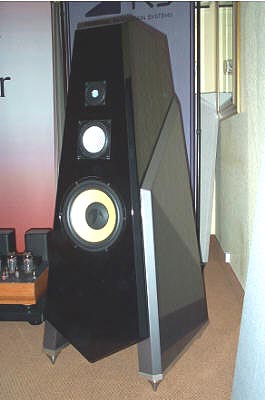 |
 |
|||||||||
Not content to be pigeon-holed, Tenor Audio has now released transitorized amps as well. Dubbed the 300Hp ($29,900/pr) and 150Hps ($17,900), the nomenclature's numbering indicates power output for, respectively, a hybrid mono and stereo amplifier. WIth detailed information sparse at the moment and the actual amp on static display only, keep checking their Canadian site for updates. If these high-power brutes can maintain the harmonic envelope of their all-tube smaller brethren, these new Tenors will be something to anticipate with eagerness! After garnering our first-ever Component-of-the-Year award for their $1,395 Unico integrated amplifier, the folks from Unison Research premiered the matching tubed Unico CD player ($1,795). |
||||||||||
 |
||||||||||
 |
||||||||||
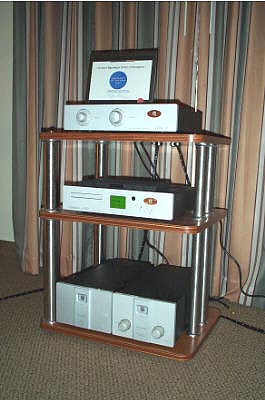 |
||||||||||
 |
||||||||||
As you know, it's impossible to tell from any demonstration where the final sound is always the sum total of system, room and momentary mood. But just seeing the Unico CD with its finely wrought metal-wood remote and tightly managed interior warmed my heart. Based on the overall demo with Triangle speakers, I intuited a very real possibility that this, like its overachieving amplification mate, could well be another giant slayer. Fit'n'finish are what you would by now expect from Unison Research -- but still don't quite have a right to considering their aggressively competitive pricing -- and I'll pester the importer on your behalf to find out what kind of tracks this machine will carve in my own system. For now, thanks to Mr. Giovanni Sacchetti for giving us less than high-heeled audio stalkers something to dream about. Which now gets us to our final entry, a dream on the other end of the price spectrum where, if I exhausted the patience of host Hideo Kitazawa of RTL Audio and his silent Japanese master Kazutoshi Yamada of Zanden, neither let on while I spun track after track as though partially in a trance. |
||||||||||
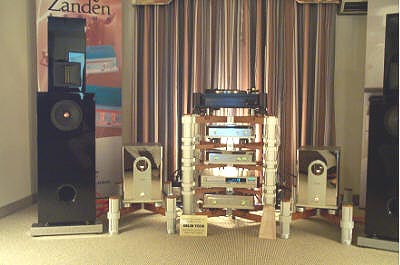 |
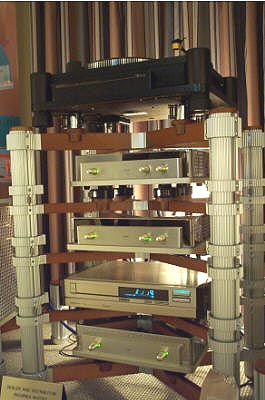 |
|||||||||
Using a Nakamichi Dragon turntable with Ikeda cartridge, Mr. Yamada first demonstrated the unique triple equalization curve feature of his Model 1200 phonostage ($1,500). Having spent more than a decade researching the matter, he discovered that most Decca and Columbia pressing deviate from the standard RIAA EQ curve and require an inverse deflection to account for the 4-6dB rise that begins at 200Hz and is up 4 and 5.8dB at 40Hz already. Having developed the proper equalization curves, Yamada then spent years cataloging recommended settings for 50+ labels. Could I hear the difference between standard RIAA and the proper setting in an A/B? Would I admit to it in public if I couldnt? Hell, this was easy and testament to Mr. Yamada's passionate research. If you own records from Bluenote, Capitol, EMI, Impulse, London, Odeon, Reprise, Savoy, Telefunken just to name a few, you haven't heard proper tonal balance until you were to move beyond the standard RIAA playback convention. Remember, these recording engineers did not EQ for it themselves. The Zanden Model 9500 845-based 100-watt monoblocks ($30,000/pr) hitched to the Zanden Model 5000MkII DAC ($10,000) and controlled by the Model 300 preamplifier ($10,000) to power the German physicist Juergen Scheuring's Ascendo System M 3-way bandpath ribbon loudspeakers made music. This presentation had weight and speed but, foremost, effusive elegance mixed with the organic quality already spotted in the Cain & Cain and 47Laboratory exhibits where it was more "earthbound" and "jovial". This Zanden setup was "transcendental". Can you forgive us poor writers for having to pin labels to such elusive experiences as merging into the oceanic feeling of music while reporting on the temperature and salt content of the water? How good was this room? Let me put it to you this way - when you secretly wipe away a few tears while in the presence of total strangers, you've come home. And this is as perfect a note as any to conclude our selective, definitely personal, admittedly biased report from the front lines in Las Vegas. Plenty of vinyl in evidence put the hex on ongoing lies about a doomed medium. Overall attendance seemed up from the previous year, and while -- in private -- most manufacturers confessed to a tough last year, most were rather upbeat about the future. After all, going dowhill means you're bound to hit return mode sooner or later. For all concerned -- which includes us listeners who purchase and enjoy this stuff and thereby put food on the table of these manufacturers -- let's hope that the need to be touched, there in the vulnerable core of an opened heart, by our favorite music, spreads to those not yet awakened to such possibilities. Remember, that has nothing to do with funds spent or complexity achieved. The gear is the medium but you're its pilot. Do you always hover 'round the same old neighborhood barely taking off? Do you habitually engage auto pilot? Or do you dare to get lost, utterly lost? |
||||||||||
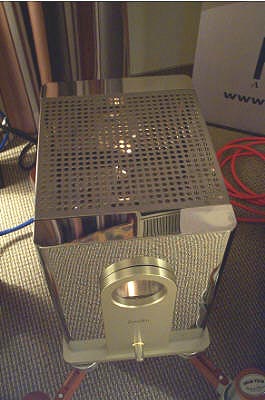 |
||||||||||
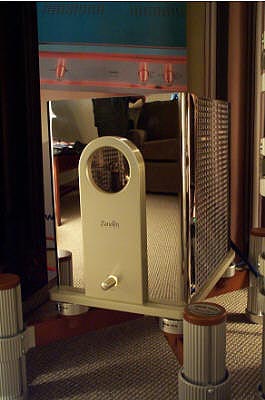 |
||||||||||
| It's funny to realize that when you get that completely lost in emotions, you're actually home - except it may not look the way you imagined it would. It's a place of great vulnerabilty when your armor is down completely. You feel everything, undiluted and raw - the bliss and the pain, the happiness and the sadness. You're no longer the inveterate tweaker but now tweaked yourself. And, you cannot have one without the other. If you can't welcome and embrace the pain, the depth of true happiness will elude you too. Isn't it magical how something as simple and innocuous as listening to music can become a barometer for how well we can let go of control and surrender? You may disagree, but for me, that's the foundation of my passion for music. It's a spiritual thing, not in an airy, ridiculous, faraway but very practical downhome sense - it's a way of intuiting spirit in our bodies, feeling it move, unfurl, expand. We differ in what music calls us forth, what audiophile ambiance relaxes us more easily into this letting-go. But I believe, we're all equally thirsty for this experience. That's our common ground, as audiophiles and music lovers. Cheers to that, my friends. |
||||||||||
 |
||||||||||
 |
||||||||||
 |
||||||||||